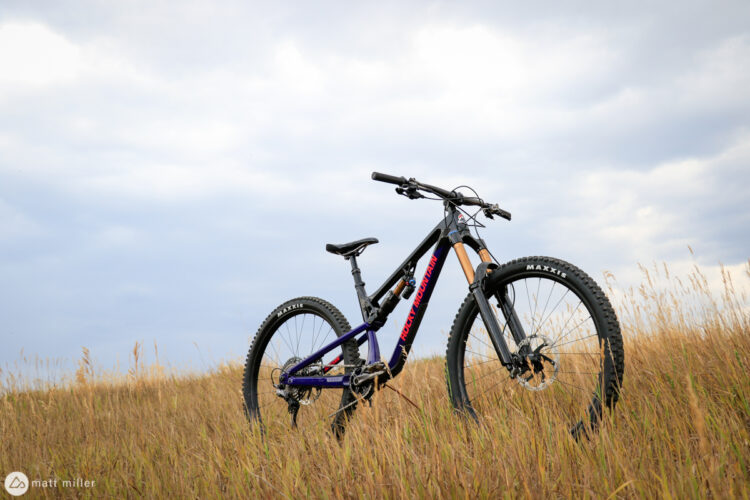Rocky Mountain stepped onto the e-bike scene in 2017 with the first Altitude Powerplay, though initially, it was only available in Europe. As demand grew, Rocky Mountain brought the Powerplay to North America and eventually brought out the Instinct Powerplay. As with any mountain bike, time and trends change, and both bikes were due for updates.

Rocky Mountain has used their Dyname electric drive system since the first Powerplays which helped keep the chainstays short and the weight slung low for ride characteristics that were closer to a non-motorized mountain bike. Visibly, the Dyname motor is quite distinct on the e-bike as sort of a blocky space sitting around and between the bottom bracket, seat tube, and down tube. With the broad downtube and a Fox 38 fork up front, it’s clear that the Altitude Powerplay is a powerful e-bike ready for anything.
What’s new?

Rocky Mountain debuted the second-generation Instincts and Altitude Powerplays at the same time. The changes are pretty similar between the two bikes, but we’ll focus more on the Altitude since that’s what I’ve been riding. The changes are broken into a few areas: geometry, the motor, and suspension kinematics.
The Dyname 4.0 drive system
While the Dyname motor still has a rather large presence, it’s 18.5% lighter than the previous version, notes Rocky Mountain. The motor still has the same 108Nm of torque and 700W of peak output.
For less drag and less noise, the motor’s RPM has been reduced to lower the “whine” and an upper chain slider that was used to reduce noise and drag has also been removed.
Be sure to read our in for test article about the Rocky Mountain Altitude Powerplay for full specs and additional photos.
About the motor, Rocky Mountain told us “There is a relationship between [the slider, the motor’s RPMs, and the high pivot], which gets down to some of the unique properties of our Dyname motor system, but first off the RPM’s have not changed from the original Dyname system to the Dyname 3.0 and including the 4.0 version. We are operating at about 1/3 of the internal RPM’s as most of the other systems, which comes with a host of benefits including less noise, less wear and tear, and less heat generated.”
Rocky Mountain gave us a few more details on how all the components of the motor work together: “On a more detailed look inside the motor we can see that our design with it’s low RPM and serviceable bottom bracket and cranks are paired with a unique torque sensor. With a 48-volt motor we operate the RPMs at a lower speed and the reduction of that initial RPM happens via an internal chain and secondarily the normal cranks and gears, fairly simple. On other designs the built-in crank/BB and strain gauge/torque sensor are paired with a planetary gear and belt drive or some combination of that to reduce the higher RPM to human levels. By removing the slider, having lower RPM’s and including a higher pivot we have achieved all of our goals to showcase the efficiency of the Dyname 4.0 system and the quality ride characteristics that Rocky Mountain has always been known for.”
The Dyname reads the torque input that’s applied to the chain and removes unwanted lag time for a more natural power response. The motor is also designed around a variable power curve meant to ease more challenging starts and prevent the bike from lurching out with too much power. Speaking of power, there are four modes: Eco, Trail, Trail+, and Ludicrous.

Other features tied to the Powerplay are the Jumbotron, a pretty sweet little display on the top tube. The Jumbotron shows everything from the motor mode, the battery level, the speed, and the total KM or mileage on the bike. Controlling the modes and Jumbotron display is a two-button remote on the left side of the handlebar next to the dropper post lever.
The battery, stored in the downtube, has been increased from 672Wh to 720Wh and is now more easily removable. It’s also expandable with an add-on battery to 1,034Wh. There are two chargers for the bike: a 4-amp and a 2-amp. The 2-amp can fully charge the battery in under eight hours, according to Rocky Mountain. The 4-amp cuts the time in half.
The suspension
Rocky Mountain does something unique with the Powerplays’ suspension that isn’t seen on their motorless bikes, and that is a mid-high-pivot design.
In an email, they told us “To be clear, the main pivot in not integrated with the motor, but rather we designed the motor and frames in tandem, so we could place the output pinion to behave as a high pivot idler as well.”
Rocky Mountain says the kinematics have better support in the leverage rate and anti-squat, and “this translates to smoother delivery to the ground with less energy loss.” The more rearward axle path on the mid-high pivot smooths trail bumps too. Both the 160mm Altitude and 140mm Instinct Powerplays get this feature.
Frame features and geometry
The Altitude Powerplay follows many of the same features found on the updated Altitude like an adjustable chainstay length and a modular shock mount. The modular shock mount is only found on carbon frames and potentially allows users to update suspension kinematics in the future. The tubing is also a bit sleeker. The Altitude and Instinct Powerplays are both 29ers.
The geometry has of course been updated too. On our medium test model in the neutral geometry position, the head tube angle is 64°, the seat tube angle is 76°, and the chainstays measure 437mm in the short position. Those measurements are quite short for an ebike. The reach is 455mm, the standover height is 835mm, and the wheelbase is 1,233mm.
On the trail

I received the Altitude Powerplay just ahead of the launch near the end of October. Fortunately, we had a delayed winter in Colorado and I managed to get some lengthy, late-season rides on the e-bike. The initial setup held no major surprises. After a full charge, the Altitude Powerplay was ready to rock.
Everything in the motor and battery department feels intuitive to use. The charger can be a little tricky to line up in the charge port on the motor. Otherwise, powering the bike on and selecting the mode is simple. Again, there are four modes: Eco, Trail, Trail+, and Ludicrous mode. These equate to 25, 45, 70, and 100% power. I’ve spent most of my time bouncing between the middle Trail, and Trail+ modes. For a bike of this weight (54.6lb, size M), Eco doesn’t do a whole lot if you’re trying to pedal with reasonable power. I haven’t found Ludicrous mode to be practical for most situations, but it’s there and fun if you’re trying to blast up a wide open fire road or something like that.
While climbing, the kinematics feel similar to Rocky Mountain’s other bikes. The first portion of travel is more active than some other bikes, and on an e-bike where you’re less mindful of energy efficiency, it means loads of traction. While the Altitude Powerplay is a big, heavy, and slack bike, the uphill handling hasn’t felt unwieldy. The 76° seat tube angle feels spot-on for the steep climbs on Colorado’s Front Range.

The Dyname’s response to pedaling input feels very fluid. It’s never lurchy or lungey. Power comes smoothly and the motor is noticeably less noisy and distracting than Shimano’s EP8. The remote buttons feel very light and there were numerous occasions where I accidentally bumped into a different mode.
Battery life seems to be on par with other full-on, 250W e-bikes. I never thought I’d run out of juice, but that’s because I charged it all the way before any big ride. Range is always hard to give a definitive estimate or answer on, but I’d say on 3-4,000ish foot rides I’d use 30-40ish percent of the battery. That’s a real rough estimate, but the Powerplay isn’t a fuel sipper.
Lastly, the Jumbotron has been a hit. This little display is conveniently located and protected at the front of the top tube, and the amount of data you can see on here is sweet. Most anyone who saw the bike commented positively on this display. Now if only there was a way to add mapping and import your rides to Strava…
Descending

No one buys an e-bike because they love descending…right? Now that I think of it, I’m not sure where descending fits in as a priority for e-bike consumers. Some might say they love descending more than anything, and the e-bike helps them get more elevation drop than a traditional bike. Others might just want an assist to get to the top of the hill, and having a 55lb enduro bike on the way down is just icing on the cake.
Wherever descending fits as a priority in your e-bike consideration, note that the Altitude Powerplay could also be dubbed the Plow-erplay. This thing has been a wicked amount of fun downhill. Combining Rocky’s ground-hugging yet supportive suspension characteristics with the low-slung weight of the motor and sharp geometry equals a recipe for confidence.
I expected a bike that was unwieldy, hard to stop, too ground-huggy, and sort of deadweight on the downhills. The Altitude Powerplay is still much harder to get in the air than the Altitude — you need more speed and bigger lips or ledges — but with the right mix, the bike is surprisingly snappy off jumps. And, unsurprisingly stable.
There are some laws of physics happening here… an object in motion tends to — something. Don’t ask me, I’m a writer, but once this bike gets moving, it feels invincible. The suspension feels supportive enough to carve corners and pop off of lips at speed, but traction and end stroke suspension feel limitless.
Thank goodness Rocky Mountain threw CushCore tire inserts into these wheels, which now come stock on select models. I didn’t have any problems with this build. With all Fox and Shimano, everything operated as expected. I would not have minded a larger rotor up front. This comes with 203s front and back and stopping power is decent, but a little more would be even better. Throwing organic pads in the calipers could help too.
Pros and cons of the 2022 Rocky Mountain Altitude Powerplay
Pros
- Subtle motor noise and smooth power delivery
- Fun to descend on (not all e-bikes are)
- 4 power modes which can be tailored to personal preference
- Good traction and suspension performance
Cons
- Expensive
- Heavy
- Could use a touch more braking power

Closing thoughts
The Altitude Powerplay is a lot of bike and there’s a lot to like about it. The motor is seamless and quiet and the powertrain’s position gives it an aggressive feel on descents. The geometry is confidence-inspiring on the descents and still agile enough when singletrack is narrow.
I’m not saying that shorter or mid-travel e-bikes don’t have a place. Obviously, they do for certain terrain, but if I were picturing my ideal e-bike, the Altitude Powerplay would likely be it. If your bike is going to have a motor, why not get the most bike you can take uphill with it? 160mm of rear travel, a Fox 38 up front, burly tires with CushCore squeezed between the sidewalls. Weight becomes a small consideration. Optimizing the descent becomes a greater consideration.
Now that I think about it, if I were buying an e-bike, descending would be my priority and I’d want to get as many laps with minimal effort as I could on a long-travel bike. The Altitude Powerplay is great for the mission.
MSRP: $9,059












1 Comments
Mar 1, 2022